|
|
| RHP |
South African
River Health Programme
|
State of the Rivers Report
uMngeni River and Neighbouring Rivers and Streams
|
|
The uMngeni River rises in the uMngeni Vlei area, an ancient wetland surrounded by a rim of hills, at the west end of the catchment 1 760m above sea level. From its source, the uMngeni River flows eastward through rolling pastoral landscape and is joined by the Lions River before flowing into Midmar Dam, a popular sport and recreation resource. The river channel is narrow, overhung by grassed banks, fine-leaved shrubs and occasional trees. River habitats here are predominantly riffles and pools. Cascades are common due to hard dolerite rock. The main land use in this region is forestry and agriculture.
|
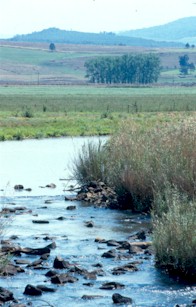
|
|
Water quality in this resource unit is generally Good.
Riparian habitats are degraded by invasive trees such as wattles, gums and pines but are in good condition.
Instream habitat is Good, although the large number of farm dams have modified water flow, which in turn affects downstream habitats.
Invertebrate condition appears close to Natural. Fish are in good condition but lower down are only in Fair condition due to the impact of aliens (trout, carp and bass) and invasive indigenous catfish. For most biota the upper reaches of the uMngeni and Lions Rivers are in better condition than downstream towards Midmar Dam.
|
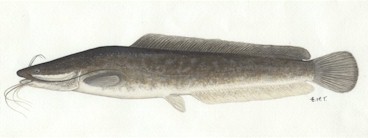
|
The Sharptooth catfish (barbel) although indigenous to KZN, never originally occurred upstream of Howick Falls. today it is an alien species in Midmar Dam and upstream.
|
|
Damage to wetlands is widespread (see page 15).
Plantation forests contribute to excessive sedimentation and destabilisation of riverbanks. These trees (as well as invasive alien plants) also use a lot of water, over-shade the river and displace indigenous vegetation.
The construction of Midmar Dam transformed what used to be a large natural wetland. There are also numerous farm dams in the catchment. See p. 30 for more detail about the impact of dams on river health.
Agriculture, in particular dairies, piggeries and maize production, impact moderately on river health through excessive nutrient input into rivers.
The interbasin transfer of water from the Mooi River to the uMngeni system is a potential threat to the health of both river systems through flow alteration and genetic mixing of biota.
|
|
This is the main water catchment for the KwaZulu-Natal (KZN) Midlands, providing high quality potable water right down to Kloof and the Inanda valley.
Wetlands contribute to the sustained provision of water through dry periods and even maintained supply during the dry early 1980s and 1990s.
Water is used for pasture irrigation, forestry and other forms of dryland agriculture.
Value of conserving rare and endangered habitats and species, e.g. wattled crane of the uMngeni vlei and the endemic mountain malachite dragonfly. Also present is the rare plant Hydrostachys which grows in waterfalls in this area.
The river and the many dams in the area provide for sport and recreation. Indigenous (the KZN yellowfish is a demon to catch!) and exotic fish e.g. trout in cool headwater streams and dams, are popular catches here. Midmar Dam is a hub for water sports including the famous Midmar Mile that draws thousands of swimmers.
|
|
Prevent further loss of wetlands and protect existing wetlands.
Plantation forests should continue to be managed sensitively, and options for new plantings restricted.
Continued alien plant management, in and outside of the riparian zone. Recent improvements in the management of plantations and alien plants by forest companies and Umgeni Water are commendable.
Piggery and dairy effluents and sediment and nutrient loads from lands under maize and pasture should be managed.
Pollution from the growing Mphophomeni settlement requires management.
Water savings through water demand management can be redirected to maintain and improve river health and thus river-based goods and services.
Proper fire management is needed, as excessive burning can negatively affect wetland vegetation, damage mist belt forests and impair the soil's ability to absorb rainwater.
|
| TROUT IN THE UPPER UMNGENI RIVER
|
|
|
Brown trout (introduced here in 1890) are found in the upper uMngeni River while rainbow trout (used for recreational angling) are found in dams of the upper catchment. Although breeding takes place in some streams where suitable gravel beds exist, reproduction in the streams is limited and populations are generally maintained by the annual introduction of trout reared in hatcheries.
|
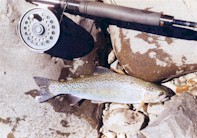
|
|
Trout, being an alien predator, adds a new component to the aquatic ecosystem. The most obvious impact on the uMngeni resulting from trout angling has been the construction of more farm dams. Trout prey on indigenous animals but the impact appears to be minimal. Frogs are preyed on both as adults and as tadpoles although a large portion of the frog population is inaccessible to fish predators. The indigenous Natal mountain catfish is preyed on by trout but they occur in streams that are too small for trout and their cryptic lifestyle reduce their vulnerability. Crabs and aquatic insects are a notable item in the trout diet. Some species are more subject to predation than others, but anything more than a local reduction in abundance seems unlikely. In the uMngeni River, trout are nowhere present in large numbers and the measurable effect on invertebrate prey is likely to be minimal.
The presence of trout is the subject of an ongoing controversy as many feel that trout have no place in South African rivers.
|
| WETLANDS IN THE UMNGENI CATCHMENT
|
|
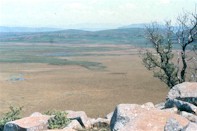
|
Wetlands in this catchment are most abundant upstream of Midmar Dam, and those in the headwaters are known as "the uMngeni sponge". Some of these wetlands are formally conserved (protected by KZN Wildlife) and they are important breeding areas for the threatened wattled crane.
|
|
Many of the catchment's wetlands have been destroyed by human activities and the state of the remaining wetlands varies greatly. Some are in good condition while others are degraded and their original functions impaired. Currently, the most significant threats to wetlands here are cultivation, artificial drainage, dams and urbanization (especially in the Pietermaritzburg and Durban areas), alien plant invasion, overgrazing and too frequent burning. At the highest altitudes, approximately half of the original wetland area has been lost, while below this the loss has been greater than 60%.
The continued loss and degradation of uMngeni wetlands is serious given their positive impact on river health by purifying water, controlling erosion and regulating water flow through the catchment.
Forestry companies in the area are contributing to wetland restoration by removing exotic forest trees planted within wetland areas in the catchment.
|
|
A study by Umgeni Water in the iMpofana catchment (below Michaelhouse School) showed how effective the removal of alien vegetation is in improving water yield. Thus, leaving these trees to grow and spread would cause a substantial decline in future water yield.
|
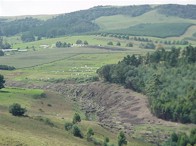
|
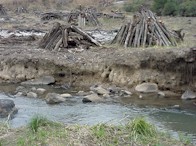
|
Alien plants require ongoing management but their removal is cheaper than investing capital in infrastructure such as pumping schemes or new dams. There are also numerous other benefits. Since the project started in 1999, it has provided income to more than 160 rural families and it has been used as a vehicle to educate children about environmental concerns. Trade has also been generated through new micro-enterprises such as fire-wood and charcoal production. Other benefits include reduced soil erosion by improving indigenous vegetation cover, improving the status of wetlands and increasing the area for stock grazing.
|
|
Since the start of this project, the Department of Agriculture has grouped alien invasive plants according to their potential impact. For example, a Category 2 invader such as black wattle, may only be grown under controlled circumstances.
|
|